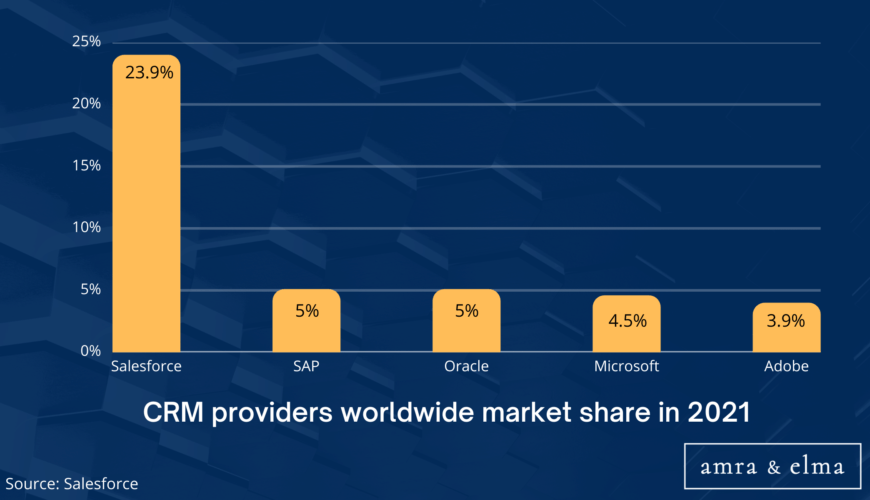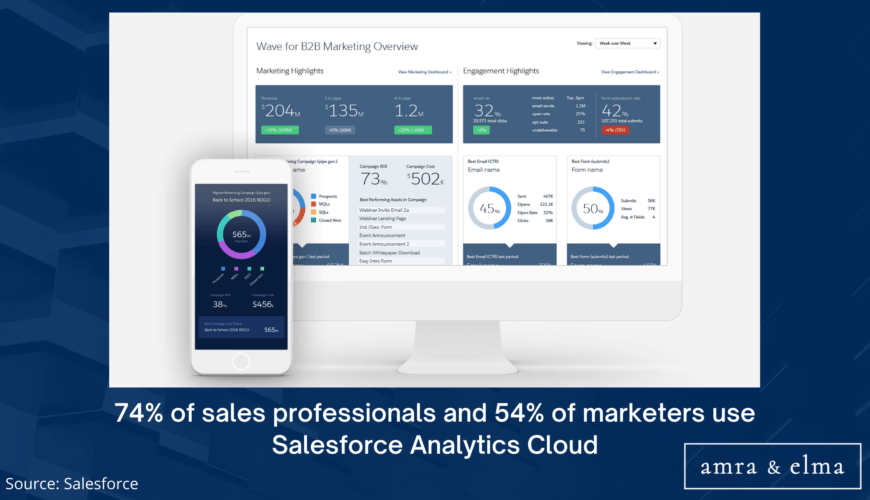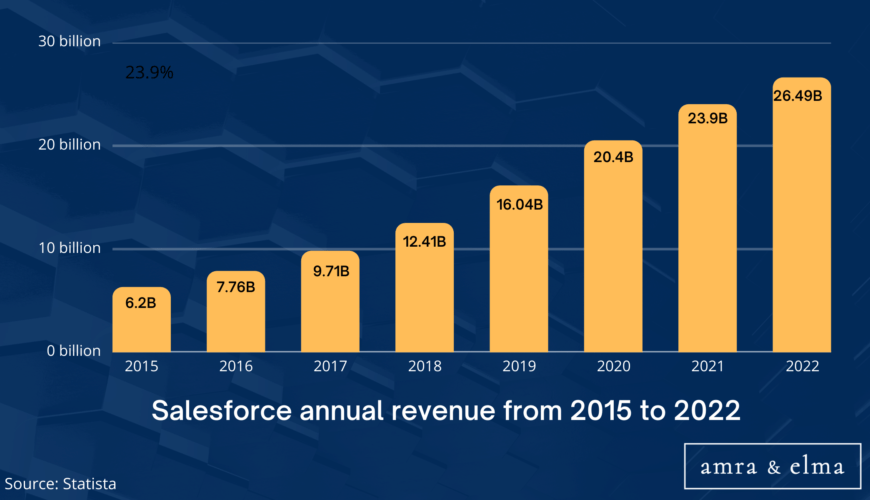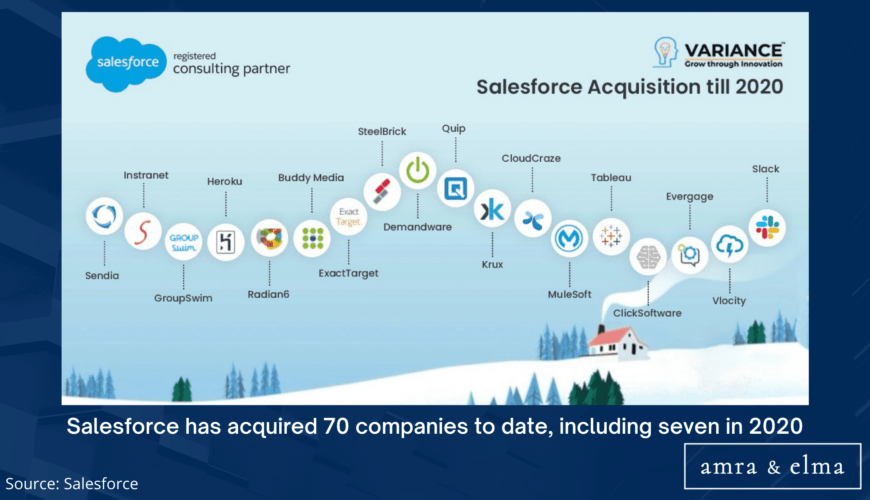
26 May TOP SALESFORCE STATISTICS IN 2023 (UPDATED)
Salesforce is the leading vendor in the customer relationship management (CRM) applications market worldwide. The company has a market share of 23.9 percent in 2021, a significant margin over the next in line to Salesforce, SAP, and Oracle, with around five percent shares of the market. More than 150,000 companies worldwide use Salesforce tools in different departments and business areas. By using Salesforce, customers can increase efficiency and transparency of their sales processes, obtain 360-degree views of their customers, and accelerate decision making throughout their organizations. According to the official statistics from Salesforce, 52% of companies saw an increase in lead volume when they started using Salesforce, a 27% boost in win rate, and a 34% rise in sales revenue.
Below, we highlight 15 key Salesforce statistics:
Salesforce Statistics (Editors Choice)
- More than 150,000 companies worldwide use Salesforce tools in different departments and business areas
- Salesforce has been ranked the #1 CRM provider worldwide with a market share of 23.9 percent
- 52% of companies saw an increase in lead volume when they started using Salesforce
- 74% of sales professionals and 54% of marketers use Salesforce Analytics Cloud
- The annual revenue of Salesforce reached a record high of 26.49 billion U.S. dollars in 2022
- Salesforce has around 73,541 employees as of 2021
Salesforce Statistics: 15 Top Salesforce Statistics in 2023!
Salesforce is the leading vendor in the customer relationship management (CRM) applications market worldwide. The company has a market share of 23.9 percent in 2021, a significant margin over the next in line to Salesforce, SAP, and Oracle, with around five percent shares of the market. Next in line are Microsoft, Adobe, and others, with much smaller percentages. Salesforce’s success is due to several factors. First, the company has been an innovator in the CRM space, developing new features and functionality that have made its products more attractive to customers. Second, Salesforce has invested heavily in marketing and sales efforts, building brand awareness and mindshare among potential customers. Third, the company has a robust ecosystem of partners and developers who create add-on products and services that extend the value of its core offerings. Finally, Salesforce has successfully executed its go-to-market strategy, signing up large numbers of customers and growing its revenues at a rapid pace.

Salesforce Statistics #2: More than 150,000 companies worldwide use Salesforce tools in different departments and business areas.
As the world’s leading customer relationship management (CRM) software provider, Salesforce has more than 150,000 customers in various industries. Salesforce tools are used in every major business area, including sales, marketing, customer service, and support. In addition, Salesforce provides the data to back up its leadership position in the CRM market. According to Gartner, Salesforce is the leader in all five major CRM categories: cloud-based solutions, mobile CRM, social CRM, analytics, and engagement. With such a broad base of customers and such a strong showing in independent research, it’s no wonder that Salesforce is the clear leader in the CRM market.
Salesforce Statistics #3: In 2021, 30% of Salesforce customers came from the professional services industry.
In 2021, almost 30% of Salesforce customers came from the professional services industry. This is partly because Salesforce provides a wide range of tools that can be used to streamline operations and improve customer service. Other core segments include manufacturing (11.1%) and banking and financial services (8.8%). Salesforce has also been making inroads into the healthcare sector, with 6.7% of customers coming from this industry. The company’s various cloud-based offerings have proved to be particularly popular with healthcare organizations, often looking for ways to improve patient care while reducing costs.
Salesforce Statistics #4: 52% of companies saw an increase in lead volume when they started using Salesforce.
According to the official stats from Salesforce, 52% of companies saw an increase in lead volume when they started using Salesforce, a 27% boost in win rate, and a 34% rise in sales revenue. While these numbers are impressive, they do not tell the whole story. The real power of Salesforce lies in its ability to help customers close more deals and drive more revenue. Salesforce gives the insights needed to identify the best leads, track progress with each customer, and close more deals with its powerful CRM tools. In addition, Salesforce provides a wide range of marketing and sales automation features that make it easy to manage the sales pipeline and stay on top of sales goals. As a result, it is no wonder that so many companies see a boost in sales when they start using Salesforce.
Salesforce Statistics #5: 74% of sales professionals and 54% of marketers use Salesforce Analytics Cloud.
According to the latest report from Salesforce, 74% of sales professionals and 54% of marketers use Salesforce Analytics Cloud. The report found that the use of Salesforce Analytics Cloud has grown steadily over the past year, with more than half of respondents saying they use it daily. In addition, most users said they were satisfied with the product, with nearly 80% rating it as either “excellent” or “good.” Salesforce Analytics Cloud is a powerful tool that provides users with real-time insights into their sales pipeline, customer data, and marketing performance. With its ability to surface actionable intelligence, it is no wonder that its adoption is on the rise. For businesses looking to get more out of their data, Salesforce Analytics Cloud is worth considering.

Salesforce Statistics #6: Salesforce AppExchange is the world’s largest business applications marketplace, home to 4,600 apps.
AppExchange is the world’s largest business applications marketplace, home to 4,600 apps. Salesforce AppExchange is a cloud-based application marketplace that enables enterprises to find, try, buy, and deploy State of the art pre-integrated solutions that extend Salesforce’s reach and capabilities. Customers can evaluate and choose from a growing ecosystem of ready-to-install applications, components, and services available on AppExchange. SFDC has over 4 million subscribers, and this number is expected to grow as the company continues to invest in its ecosystem. This growth will result in more enterprise applications being built on the AppExchange platform, and more businesses will be able to take advantage of the power of the Salesforce app ecosystem.
Salesforce Statistics #7: 39% of Salesforce Customers say data cleansing is the essential app in the AppExchange.
Data cleansing is the process of identifying and correcting inaccuracies and inconsistencies in data. It is a vital part of maintaining data quality and ensuring that decision-makers have access to accurate information. Salesforce customers have rated data cleansing as the essential app on the AppExchange, with 39% of respondents citing it as their top choice. This is likely because Salesforce data is often used for critical decision-making. Inaccurate data can lead to poor decision-making, which can hurt business operations. Data cleansing helps ensure that information is accurate and reliable, making it a valuable tool for any organization that uses Salesforce.
Salesforce Statistics #8: The annual revenue of Salesforce reached a record high of 26.49 billion U.S. dollars in 2022.
According to Statista, the annual revenue of Salesforce reached a record high of 26.49 billion U.S. dollars in its 2022 fiscal year. This is mainly due to the continued sales boom in the company’s subscription and support business segment, which brought in close to 25 billion U.S. dollars in revenue in the same fiscal year. This marks an impressive increase from the 20.4 billion U.S. dollars in revenue that Salesforce generated in its 2020 fiscal year. With continued growth like this, it is clear that Salesforce is cementing its position as one of the leading providers of cloud-based customer relationship management (CRM) software solutions.

Salesforce Statistics #9: Salesforce generated over one billion U.S. dollars in net income in 2022.
According to Statista, Salesforce generated over one billion U.S. dollars in net income in 2022. This was considerably lower than the company’s net income in the previous year but remained higher than the last peak in 2019 when its net income amounted to 1.11 billion U.S. dollars. However, despite the decrease in net income, Salesforce still performed better than most of its competitors in the enterprise software market. Its closest competitor, Oracle, only generated a little over half of Salesforce’s net income in the same period. This highlights the strength of Salesforce’s business model and its ability to generate healthy profits even in challenging economic conditions. Looking forward, it is likely that Salesforce will continue to perform well financially as demand for its cloud-based software solutions remains strong.
Salesforce Statistics #10: The U.S. is Salesforce’s largest regional market, bringing in about 18 billion U.S. dollars for the software company in 2022.
According to the latest data from Statista, the Americas is Salesforce’s largest regional market, bringing in about 18 billion U.S. dollars for the software company in its 2022 fiscal year ending in January 2022. The overall revenue in that year reached 26.49 billion U.S. dollars, a record high. Subscription and support is Salesforce’s most prolific business division – sales in this segment contributed 25 billion U.S. dollars to its overall revenue. The Americas accounted for 68 percent of Salesforce’s total revenue in the said fiscal year, with Europe, the Middle East, and Africa (EMEA) contributing 17 percent and Asia-Pacific bringing in 15 percent. North America is the largest market for Salesforce within the Americas region, accounting for 58 percent of its revenue in the continent in 2020. Latin America followed this at 33 percent and Canada at 9 percent. It is clear that the Americas is essential to Salesforce’s continued success as a leading provider of cloud-based customer relationship management (CRM software) solutions.
Salesforce Statistics #11: Salesforce has around 73,541 employees as of 2021.
According to the latest data from Statista, Salesforce.com has around 73,541 employees as of 2021. Salesforce’s number of employees has increased during the measured period, almost doubling itself since 2019. Of Salesforce’s employees, 50.7% are members of underrepresented groups. Salesforce operates in 84 cities, with 110 offices around the world. There are eight Salesforce Towers currently (in Atlanta, Dublin, Indianapolis, London, New York, Paris, San Francisco, and Tokyo), with another two in development (Salesforce Tower Sydney and Salesforce Tower Chicago). These numbers underscore Salesforce’s commitment to diversity and inclusion, as well as its global reach.

Salesforce Statistics #12: Salesforce has spent $22 million to ensure equal pay for equal work among its global workforce.
When it comes to ensuring equal pay for equal work, Salesforce leads by example. In 2015, the company committed to investigating and addressing gender pay gaps within its global workforce. Since then, Salesforce has continued to improve upon its processes and broaden the scope of assessment to include bonuses, promotions, stock, race, and ethnicity in the United States and gender globally. So far, Salesforce has spent $22 million to close salary disparities among its employees. And it does not stop there – the company is also working to eliminate discrepancies in bonuses and promotions. By taking these bold steps, Salesforce sets a strong precedent for other companies to follow suit in ensuring fairness and equality in the workplace.
Salesforce Statistics #13: In 2021, Salesforce achieved net-zero emissions across its entire value chain and reached 100% renewable energy.
In 2021, Salesforce achieved net-zero emissions across its entire value chain and reached 100% renewable energy. This is a significant milestone for the company that underlines its commitment to sustainability. The move to renewable energy will help to reduce Salesforce’s environmental impact and contribute to a cleaner, more sustainable future. In addition, the move will also help improve the company’s bottom line by reducing energy costs. With this milestone, Salesforce is leading the way in sustainable business practices and setting an example for other companies to follow.
Salesforce Statistics #14: Salesforce has acquired 70 companies to date, including seven in 2020.
Salesforce’s success in the enterprise software market is mainly due to its aggressive acquisition strategy. To date, Salesforce has acquired 70 companies, including seven in 2020. A significant portion of Salesforce’s massive growth is attributed to acquisitions of high-profile companies, including Tableau, MuleSoft, Demandware, ExactTarget, and Vlocity. In 2020, Salesforce’s investment in acquisitions reached $29.1 billion. Furthermore, in 2021, Salesforce completed its acquisition of Slack, a leading messaging platform that will form the crux of Salesforce’s Customer 360 platform, for $27.7 billion. These acquisitions have helped Salesforce solidify its position as a leading enterprise software provider and establish a robust ecosystem of products and services.

Salesforce Statistics #15: The Salesforce’s Trailblazer community has over 15 million members.
The Salesforce Trailblazer community is a vast and ever-growing group of individuals passionate about improving their skills and knowledge in the Salesforce ecosystem. The community has over 15 million members worldwide, making it one of the largest and most active groups of its kind. The community offers many resources, including free online courses, certification programs, and forums where users can ask questions and share ideas. In addition, the community organizes regular events, such as meetups and conferences, which allow attendees to network with like-minded individuals and learn from some of the top experts in the field.
Conclusion
This report has outlined some of the essential Salesforce statistics for 2022. These statistics underscore why Salesforce continues to be the top choice for businesses looking for a CRM solution. In terms of features, Salesforce offers a comprehensive set of tools for managing customer relationships, including contact management, sales pipeline management, and social CRM. The company also provides a wide range of customization options so that businesses can tailor the platform to their specific needs. With its combination of user-friendly features and powerful customization options, it is clear that Salesforce will continue to dominate the CRM market in the years to come.
TOP SALESFORCE STATISTICS IN 2023- FAQ:
How many people are using Salesforce?
Salesforce has more than 150,000 customers in various industries. Salesforce tools are used in every major business area, including sales, marketing, customer service, and support. In addition, Salesforce provides the data to back up its leadership position in the CRM market. According to Gartner, Salesforce is the leader in all five major CRM categories: cloud-based solutions, mobile CRM, social CRM, analytics, and engagement.
How widely used is Salesforce?
Salesforce is used worldwide, in more than 200 countries around the world. Salesforce operates in 84 cities, with 110 offices around the world. There are eight Salesforce Towers currently (in Atlanta, Dublin, Indianapolis, London, New York, Paris, San Francisco, and Tokyo), with another two in development (Salesforce Tower Sydney and Salesforce Tower Chicago).
Is Salesforce still growing?
In the last 5 years salesforce.com, inc. has increased its revenue by 215.7%, going from US8. 4b in January 2017 to US$26.5b in January 2022. This results in a CAGR of 25.8% over the last 5 years.
Is Salesforce the largest CRM?
Salesforce is the leading vendor in the customer relationship management (CRM) applications market worldwide. The company has a market share of 23.9 percent in 2021, a significant margin over the next in line to Salesforce, SAP, and Oracle, with around five percent shares of the market. Next in line are Microsoft, Adobe, and others, with much smaller percentages.
How to use Salesforce?
Salesforce is a cloud-based customer relationship management (CRM) software that allows businesses to manage their customer data, sales pipeline, and marketing campaigns. It offers a suite of tools to help businesses connect with their customers and keep track of all interactions. Salesforce also includes features that allow businesses to create custom applications or extensions to the software.
Salesforce is one of the most popular CRMs on the market and has received numerous awards for its features and functionality. If you want to know how to use salesforce, it’s first important to note that Salesforce is used by companies of all sizes, from small businesses to Fortune 500 companies. Salesforce is also highly customizable, which means businesses can tailor it to fit their specific needs.
Overall, Salesforce is an excellent CRM tool that can help businesses manage their customer data and interactions more effectively. If you’re wondering how to use salesforce, it is very practical and easy, customizable, and provides a wealth of features and functionality. If you’re looking for a good CRM solution, then Salesforce is worth considering.
If you want to know how to use Salesforce, you first need to create an account. Once you have created an account, you can log in to the Salesforce website. Once you have logged in, you will be taken to the home page, which contains a list of your recent activities and a summary of your company’s data. When discussing how to use Salesforce, to start using it, you need to create a new object. An object is a container for data related to a particular topic or activity. There are several types of objects in Salesforce, including accounts, contacts, opportunities, and leads.
To create a new object, click on the “Create” button in the top left corner of the page. This will open a menu where you can select the type of object you want to create. After selecting the type of object, you will then need to provide the required information about the object. This includes the name of the object, the description of the object, and the fields that will be included in the object.
To learn how to use salesforce, there are a few more steps to complete. Once you have created an object, you can start adding records to it. One record is a single example of an object. To add a record to an object, click on the “New” button in the top right corner of the page. This will open a menu where you can select the type of record you want to add. After selecting the type of record, you will then need to provide the required information about the record. This includes the name of the record and the information about the customer or sale associated with it.
Once you have added records to an object, you can view them by clicking on the “List” tab at the top of the page. When learning how to use Salesforce, these are some of the most relevant steps. This will open a list of all of your records for that object. You can also filter this list by using the filters at the top of the page. These filters include fields such as “Created Date”, “Last Modified Date”, “Owner”, and “Status”. You can also use advanced search operators to find specific records based on their values for certain fields.
To view detailed information about a particular record, click on its name in the list. This will open a window that displays all of the information about that record. You can also edit this information by clicking on one of its fields and entering new values into it. To delete a record from an object, click on its name in the list and then click on the “Delete” button at the bottom of the page. When learning how to use Salesforce, remember that these steps are crucial, and by doing every one of them you will learn how to use Salesforce in no time.
Why do businesses create a campaign in Salesforce?
Salesforce is an industry leader providing businesses with robust customer relationship management (CRM) solutions. It’s no secret that marketing is a critical aspect of any successful business. Salesforce recognized this by offering a comprehensive marketing automation solution that allows businesses to create a campaign in Salesforce.
Businesses today are looking for ways to streamline their marketing strategies. Salesforce has answered this call by providing a one-stop shop for creating campaigns from start to finish. Businesses choose to create a campaign in Salesforce for various reasons. One of the advantages of Salesforce’s campaign creation is that it provides companies with unparalleled visibility and control.
To create a campaign in Salesforce does not take a lot of time, but it provides businesses with immense benefits. First, it allows companies to segment their audience effectively and tailor their messaging to specific demographics, interests, behaviors, and more.
Secondly, businesses create a campaign in Salesforce because it allows companies to set measurable goals and track progress, enabling marketers to know which activities are driving leads, sales, or engagement. Salesforce provides businesses with real-time tracking and reports, allowing marketers to make data-driven decisions about which channels, messages, or offers to prioritize.
Moreover, when businesses create a campaign in Salesforce, they can leverage the platform’s advanced lead nurturing capabilities. With lead nurturing, companies can build meaningful relationships with prospects and customers based on engagement, education, and trust. Nurtured leads have a higher propensity to buy than non-nurtured leads. Businesses create a campaign in Salesforce because it allows companies to automate lead nurturing and track its effectiveness, allowing marketers to optimize their tactics and boost conversion rates.
In conclusion, it’s clear why businesses create a campaign in Salesforce. It is a must-have for everyone looking to drive growth and build meaningful relationships with prospects and customers.
How to create a campaign on Salesforce?
Everyone wanting to create a campaign in Salesforce should know that the process is pretty straightforward. Campaigns give businesses a strategic approach to reach their target audience and drive engagement. When you want to create a campaign in Salesforce, remember that a campaign can be a simple email marketing initiative, a product launch, or a complex multi-channel approach. Whatever the campaign’s scope, Salesforce can help you create a campaign that meets your business goals.
You need to follow a few steps to create a campaign in Salesforce. First, navigate to the Campaigns tab and click the “New Campaign” button. You will be redirected to a page where you can enter the relevant information about your campaign. This information includes the campaign’s name, start and end dates, type, and description.
The next step in creating a campaign in Salesforce is to make your campaign components. Campaign components are the different marketing channels you will use to promote your campaign. These channels can include email marketing, social media, advertising, direct mail, and more. In Salesforce, the different campaign components are known as Members.
Finally, with all the different campaign components in place, creating a report to track your campaign’s performance is crucial. Another thing worth mentioning is that users create a campaign in Salesforce because its reporting feature allows businesses to generate reports and dashboards to analyze the effectiveness of their campaigns.
In conclusion, you should learn to create a campaign in Salesforce because it is an essential tool for businesses to reach their target audience and drive engagement effectively. By selecting the right campaign type, components, and members and keeping track of your campaign’s performance with detailed reporting, you can achieve your marketing goals.
When you create a campaign in Salesforce, whether it’s a simple email marketing campaign or a comprehensive multi-channel approach doesn’t matter. The only important thing is that creating a campaign in Salesforce should be an integral part of any successful marketing strategy.

